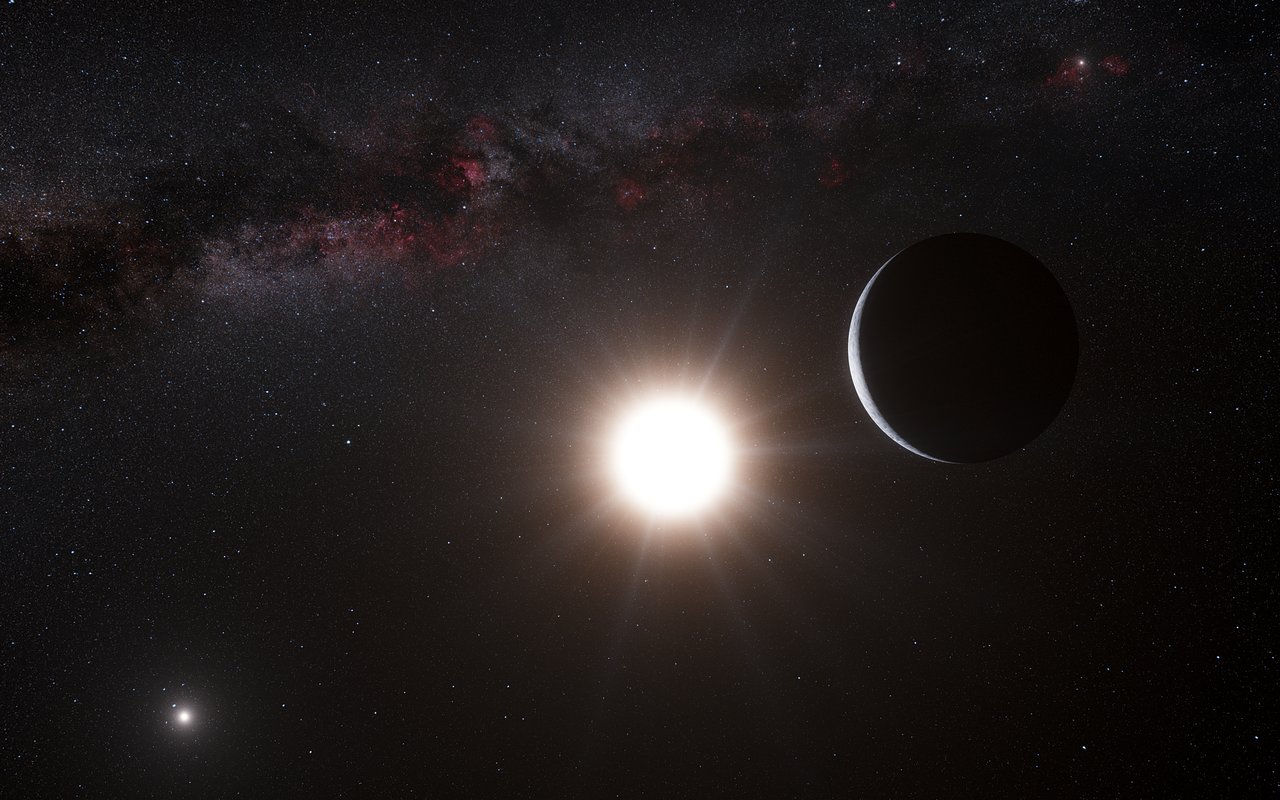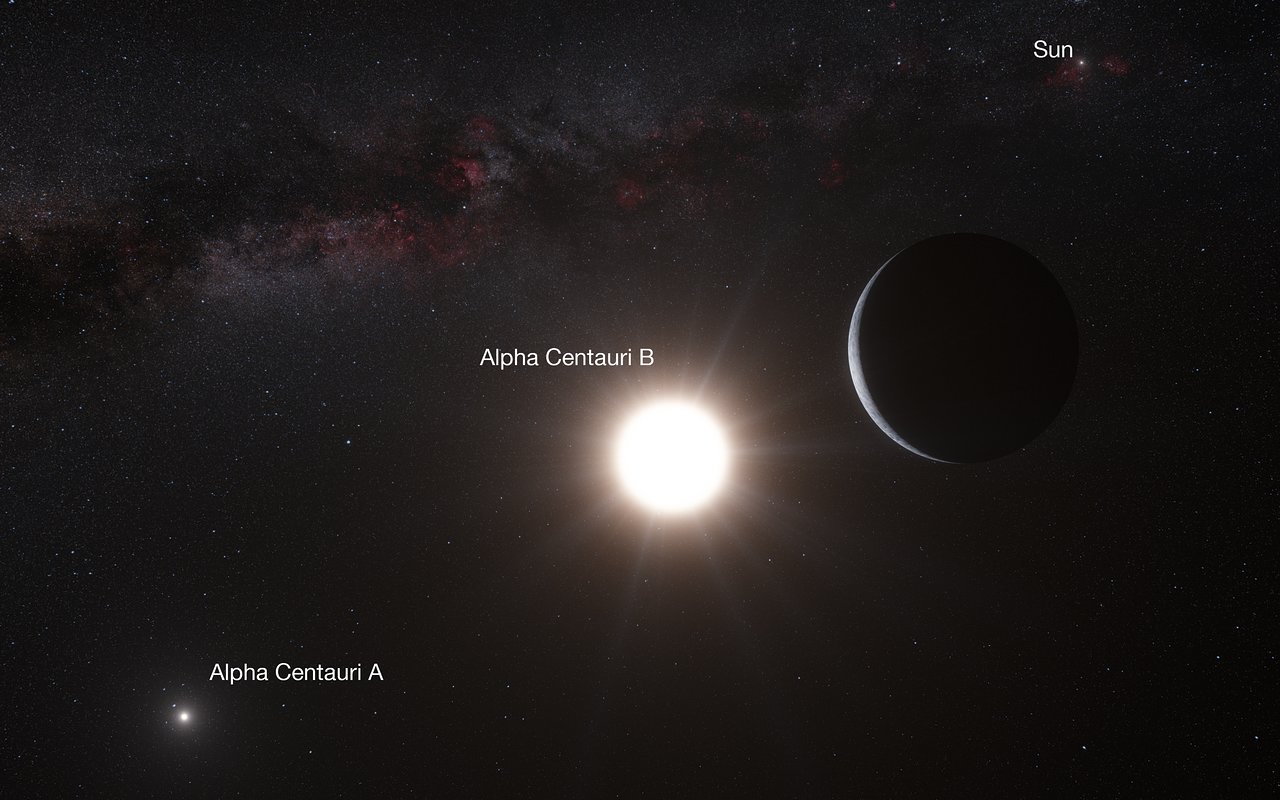European Southern Observatory | HARPS | 2012 Oct 16
ESO’s HARPS instrument finds Earth-mass exoplanet orbiting Alpha Centauri B
European astronomers have discovered a planet with about the mass of the Earth orbiting a star in the Alpha Centauri system — the nearest to Earth. It is also the lightest exoplanet ever discovered around a star like the Sun. The planet was detected using the HARPS instrument on the 3.6-metre telescope at ESO’s La Silla Observatory in Chile. The results will appear online in the journal Nature on 17 October 2012.Click to play embedded YouTube video.
Alpha Centauri is one of the brightest stars in the southern skies and is the nearest stellar system to our Solar System — only 4.3 light-years away. It is actually a triple star — a system consisting of two stars similar to the Sun orbiting close to each other, designated Alpha Centauri A and B, and a more distant and faint red component known as Proxima Centauri. Since the nineteenth century astronomers have speculated about planets orbiting these bodies, the closest possible abodes for life beyond the Solar System, but searches of increasing precision had revealed nothing. Until now.
“Our observations extended over more than four years using the HARPS instrument and have revealed a tiny, but real, signal from a planet orbiting Alpha Centauri B every 3.2 days,” says Xavier Dumusque (Geneva Observatory, Switzerland and Centro de Astrofisica da Universidade do Porto, Portugal), lead author of the paper. “It’s an extraordinary discovery and it has pushed our technique to the limit!”
The European team detected the planet by picking up the tiny wobbles in the motion of the star Alpha Centauri B created by the gravitational pull of the orbiting planet. The effect is minute — it causes the star to move back and forth by no more than 51 centimetres per second (1.8 km/hour), about the speed of a baby crawling. This is the highest precision ever achieved using this method.
Alpha Centauri B is very similar to the Sun but slightly smaller and less bright. The newly discovered planet, with a mass of a little more than that of the Earth, is orbiting about six million kilometres away from the star, much closer than Mercury is to the Sun in the Solar System. The orbit of the other bright component of the double star, Alpha Centauri A, keeps it hundreds of times further away, but it would still be a very brilliant object in the planet’s skies.
The first exoplanet around a Sun-like star was found by the same team back in 1995 and since then there have been more than 800 confirmed discoveries, but most are much bigger than the Earth, and many are as big as Jupiter. The challenge astronomers now face is to detect and characterise a planet of mass comparable to the Earth that is orbiting in the habitable zone around another star. The first step has now been taken.
“This is the first planet with a mass similar to Earth ever found around a star like the Sun. Its orbit is very close to its star and it must be much too hot for life as we know it,” adds Stéphane Udry (Geneva Observatory), a co-author of the paper and member of the team, “but it may well be just one planet in a system of several. Our other HARPS results, and new findings from Kepler, both show clearly that the majority of low-mass planets are found in such systems.”
Image Credit: ESO/L. Calçada
An Earth mass planet orbiting Alpha Centauri B - Xavier Dumusque et al
- Nature (online 17 Oct 2012) DOI: 10.1038/nature11572 (pdf)
Next Door Neighbors? Earth-Sized Planet Discovered in Nearest Star System to Us
Universe Today | Nancy Atkinson | 2012 Oct 16
Alpha Centauri Has a Planet!
Discover Blogs | Bad Astronomy | 2012 Oct 16
Earth-Sized World Found Next Door
Discovery News | Irene Klotz | 2012 Oct 16
Stellar Fingerprinting Hints Nearest Star Hosts Planets
Discovery News | Ray Villard | 2012 Oct 03
The exoplanet next door
Nature News | Eric Hand | 2012 Oct 16
ESO's HARPS instrument finds Earth-mass exoplanet orbiting Alpha Centauri B
NASA Ames Research Center | Kepler | 2012 Oct 16
ScienceShot: Earth's Ugly Twin
Science NOW | Yudhijit Bhattacharjee | 2012 Oct 17
UK astronomers celebrate discovery of new Earth-sized planet
UK Science & Technology Facilities Council | 2012 Oct 17
NASA Statement On Alpha Centauri Planet Discovery
NASA Headquarters | 2012 Oct 17
First Planet Discovered in Alpha Centauri System
Planetary Society | Bruce Betts | 2012 Oct 17
Reflections on Alpha Centauri B b
Centauri Dreams | Paul Gilster | 2012 Oct 18
Alpha Centauri Bb: An Interstellar Target?
Discovery News | Ian O'Neill | 2012 Oct 18

